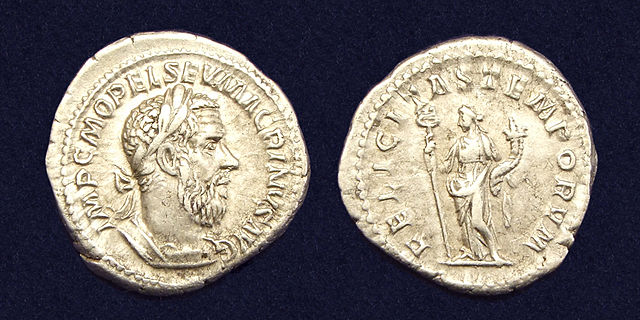In ancient Roman culture, felicitas is a condition of divinely inspired productivity, blessedness, or happiness. Felicitas could encompass both a woman's fertility and a general's luck or good fortune. The divine personification of Felicitas was cultivated as a goddess. Although felicitas may be translated as "good luck," and the goddess Felicitas shares some characteristics and attributes with Fortuna, the two were distinguished in Roman religion. Fortuna was unpredictable and her effects could be negative, as the existence of an altar to Mala Fortuna acknowledges. Felicitas, however, always had a positive significance. She appears with several epithets that focus on aspects of her divine power.
Phallic relief with the inscription "Felicitas dwells here"
AR Denarius of Macrinus, reverse side with 'FELICITAS TEMPORVM'.
AR Denarius of Caracalla, reverse side with 'FELICITAS AVGG' - Felicitas Augusti means: "To the good fortune (or happiness) of emperors"
Felicitas Temporum represented by a pair of cornucopiae on a denarius (193-194 AD) issued under Pescennius Niger
Fortuna Huiusce Diei was an aspect of the goddess Fortuna, known primarily for her temple in the Area Sacra di Largo Argentina at Rome. Cicero lists her among the deities who should be cultivated in his ideal state, because "she empowers each day". She thus embodies an important aspect of time as it figures in Roman religion: every day of the year had a distinct and potent nature, which the public priests were responsible for knowing and aligning the community with by means of the religious calendar.
Colossal head believed to be that of the cult statue of Fortuna Huiusce Diei
Ruins of the Temple of the Fortune of This Day (Temple B), Largo di Torre Argentina
Head and arm of the colossal cult statue of Fortuna Huiusce Diei, on display at the Centrale Montemartini







